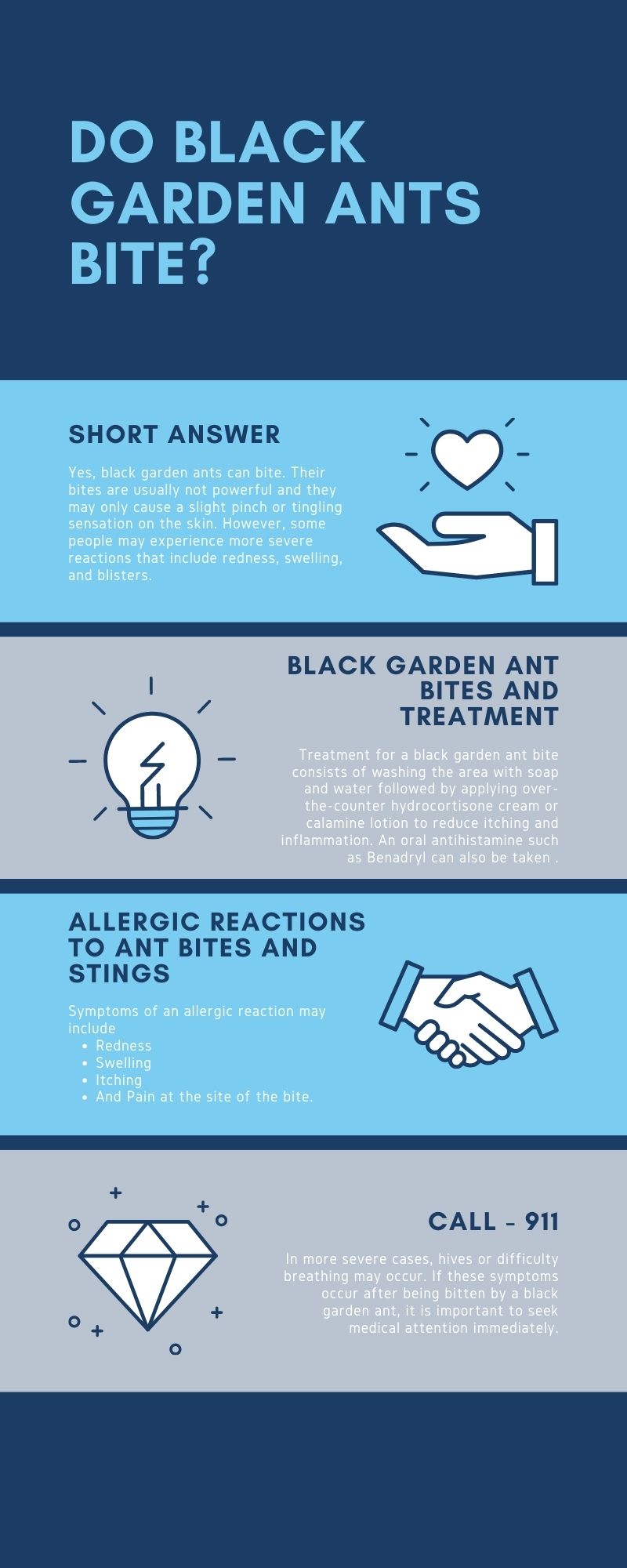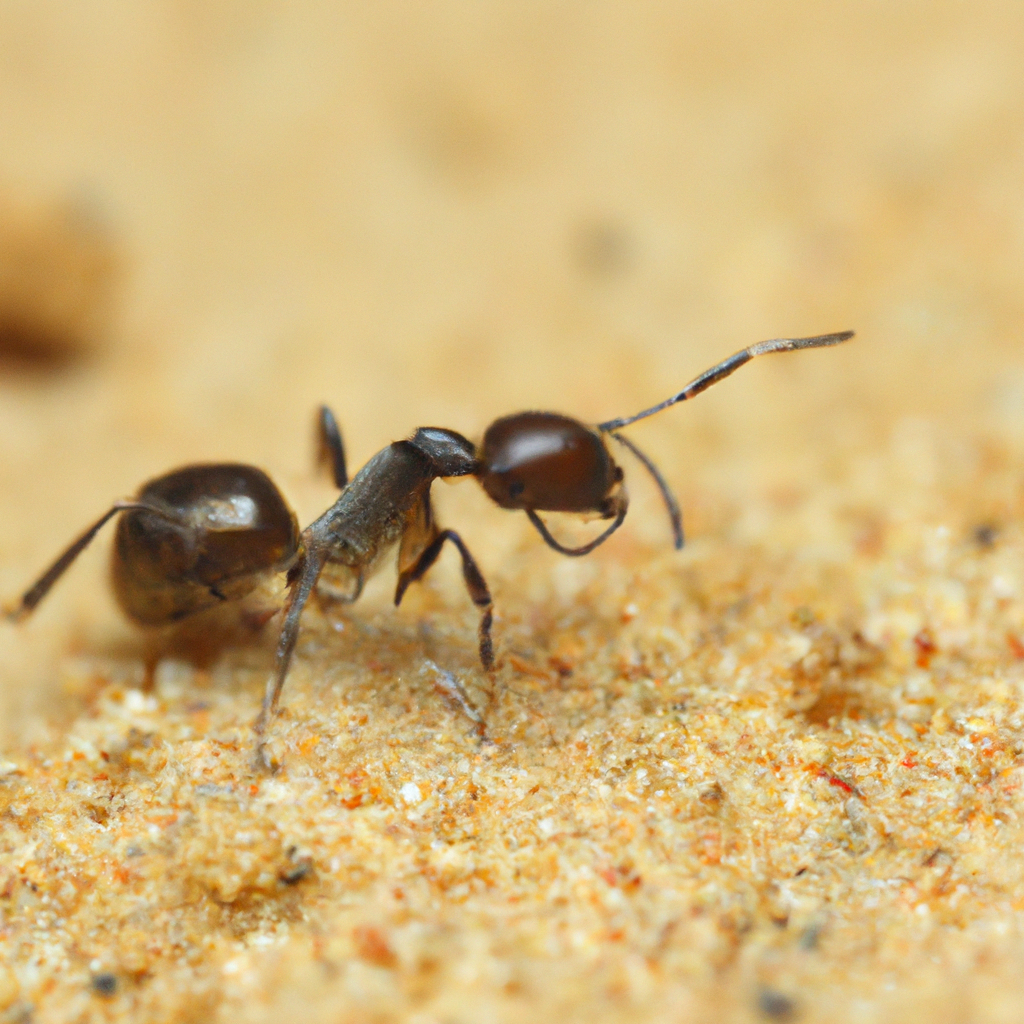Your PERSONAL ANT-CYCLOPEDIA
Black Garden Ant (L.Niger)
Black Garden Ant Scientific Classification
Phylum Belonging: Arthropods
Class of Belonging: Insects
Order To Which It Belongs: Hymenoptera
Family In Which It Is Located: Formicidae
Subfamily In Which It Is Located: Formicinae
Genus: Lasius
Species: L.Niger
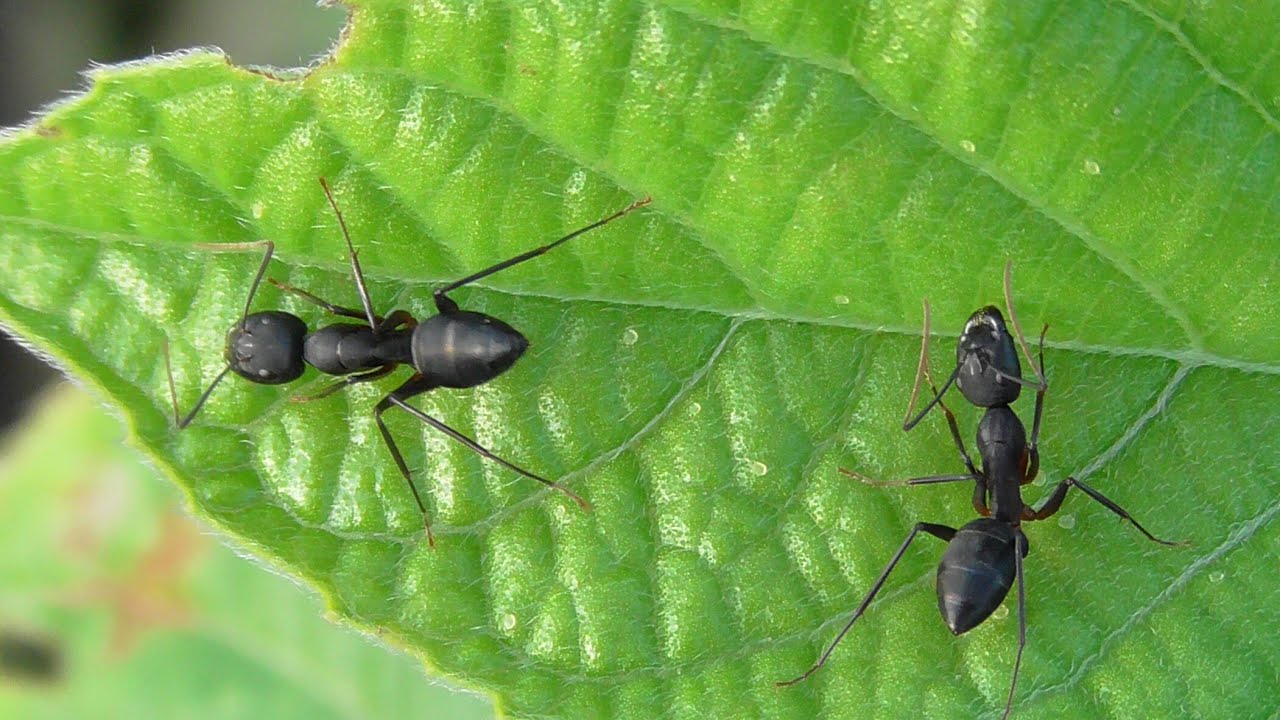
Post Audio Black Ant pending
Are you familiar with the black garden ants? These little critters may seem insignificant at first, but they actually play a crucial role in maintaining our environment.
From pollinating plants to controlling pests, black garden ants are essential components of our ecosystem. So if you’re curious to learn more about these fascinating insects and their remarkable abilities, then keep reading! In this blog post, we’ll delve into the world of black garden ants and discover all there is to know about these tiny super insects.
Black Garden Ant Identification
“Pest Stats”
| Color | Body nearly or completely concolorous medium to blackish brown |
| Legs | Typically medium brown, scapes tending to yellowish brown |
| Shape | Thorax, legs, mandibles and the antennas are slightly lighter than the rest of the body |
| Size | 2,0-5,0 millimetres |
| Antennae | Erect hairs on the antennal scapes |
| Region | They are usually found in big cities where they build their nests in houses, pavements and lawns |
What does Black Garden Ant Look Like?
Black garden ants (Lasius niger) are small, black ants that have a thorax and abdomen separated by a thin constriction. They have long legs and antennae, and they’re typically about 1/8 of an inch long. They like dark, damp places to nest in such as under stones or logs, at the base of trees or shrubs, or even in walls or chimneys.
Geographical distribution
The Black Garden Ant (Lasius niger) is found throughout Europe, North Africa, and parts of Asia. It can be found in many different habitats, including grasslands, urban areas, gardens, parks and woodlands.
Black Garden Ant Distribution Map In Us
This Artropod is found throughout most of the United States and southern Canada, with a range extending from the eastern seaboard to California. The highest concentrations are found along the Pacific coast, in Texas and Oklahoma, as well as in the Midwest states of Illinois and Indiana.
FULL LIST OF STATES WHERE WE CAN FIND THE LASIUS NIGER:
Black Garden Ant Texas
Black Garden Ant Distribution By Country
Australia: The black garden ant (Lasius niger) is native to Australia. It is found in all states, with the exception of the Northern Territory.
United States: Black garden ants are not native to this country but have been introduced from Europe and Africa. They are established in many parts of the United States, including California, Florida, Georgia, Maryland, New Jersey, New York and Pennsylvania.
Canada: The black garden ant has become naturalized in southern Ontario over time and can now be found throughout much of Canada. Additionally it has been reported as far north as Whitehorse in Yukon Territory and Vancouver Island on British Columbia’s west coast.
United Kingdom: This species is widespread across Britain though it appears to be absent from Scotland’s Outer Hebrides Islands and some other small islands off mainland UK such as Lundy island off Devon’s Heritage Coastline or the Isle of Man or Channel Islands.
New Zealand: The black garden ant was introduced into New Zealand during colonization where it quickly became established across both North and South Islands
FULL LIST OF COUNTRIES WHERE WE CAN FIND THE LASIUS NIGER:
Black Garden Ant Australia



Join The Ant Farming Club!
If you are looking for an Ant Farm and you don’t know which one to choose, or on the other hand you already have your first ant farm, but you don’t know how to grow your colony, take care of it or feed it. Here we offer you the best tips and products to make your colony grow healthy and strong.
In the next section, you will also find advice from professionals to choose the best products on the market such as:
- Luminous Gel
- Ant Farm Sand
- LED light
- Live Ants
- Full Ant Farm Kits For Kids
Ant Farming Club is perfect for kids wanting their first ant farm or schoolteachers wanting to show their students the biology of ants in a natural habitat.
Join
Join and learn all about the world of ants and ant farming.
Products & Discounts
Find discounts and advice from professionals about the best products on the market in 2022.
Meet
Connect with people who are passionate about the world of entomology.
Do Black Garden Ants Bite?
Yes, black garden ants can bite. Their bites are usually not powerful and they may only cause a slight pinch or tingling sensation on the skin. However, some people may experience more severe reactions that include redness, swelling, and blisters.
Black Garden Ant Bites and Treatment
Black garden ants are not known to bite humans and do not cause any injury or harm. However, some people may experience an allergic reaction after being bitten by a black garden ant.
Treatment for a black garden ant bite consists of washing the area with soap and water followed by applying over-the-counter hydrocortisone cream or calamine lotion to reduce itching and inflammation. An oral antihistamine such as Benadryl can also be taken if necessary to reduce itching and swelling associated with an allergic reaction.
Allergic reactions to ant bites and stings
Symptoms of an allergic reaction may include
- Redness
- Swelling
- Itching
- And Pain at the site of the bite.
In more severe cases, hives or difficulty breathing may occur. If these symptoms occur after being bitten by a black garden ant, it is important to seek medical attention immediately.
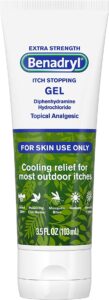
About this item
- Benadryl Extra-Strength Anti-Itch Gel temporarily relieves pain and itching associated with insect bites, minor burns, sunburn, minor skin irritations and rashes due to poison ivy, poison oak and poison sumac.
- Topical analgesic gel provides cooling, anti-itch relief from most minor pains and outdoor itches associated with insect bites.
- The cooling gel provides the relief of pain and itching associated with insect bites.

More Immediate Treatment management:
Immediate Treatment management may include:
1. Apply a cold compress or ice pack to the affected area to reduce swelling and pain.
2. Take a pain reliever such as ibuprofen, aspirin, or acetaminophen.
3. Clean the wound with soap and water, then apply some antibiotic cream or lotion (such as Neosporin) and cover it with a sterile bandage if necessary.
4. Make sure any clothing worn is loose enough not to press against the affected area as this may worsen symptoms of discomfort or itching in that location.
5. Monitor for signs of infection such as increased redness, warmth around the bite site, pus drainage from wounds etc., which could indicate an allergic reaction needs medical attention right away!

About this item
- Benadryl Extra-Strength Anti-Itch Gel temporarily relieves pain and itching associated with insect bites, minor burns, sunburn, minor skin irritations and rashes due to poison ivy, poison oak and poison sumac.
- Topical analgesic gel provides cooling, anti-itch relief from most minor pains and outdoor itches associated with insect bites.
- The cooling gel provides the relief of pain and itching associated with insect bites.

YOU CAN ALSO LISTEN HERE!
Post Audio Black Ant pending
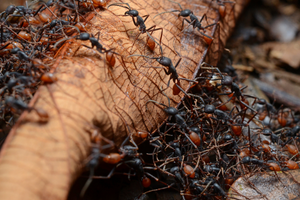
Natural Behavior Black Garden Ant
Ants are indeed an incredibly interesting species, and studies of their social organization have proven useful in understanding many aspects of our own life in society. Now, in this section, we are going to delve into the fascinating world of black ants and their natural behaviors.
The black garden ant is a species of ant that can be found in gardens, lawns, and other areas of urban landscapes throughout the world.
In its natural habitat, this species creates nests in the soil or under stones and logs. It feeds on honeydew from aphids, as well as nectar from flowers.
During warmer months it also scavenges for dead insects and other small animals to consume. When disturbed by predators like birds or lizards, these ants will release pheromones to alert nearby colonies for help. They are highly social creatures that communicate with one another through sounds and chemical signals.

Funny Fact About Black Garden Ant
Nature Traders
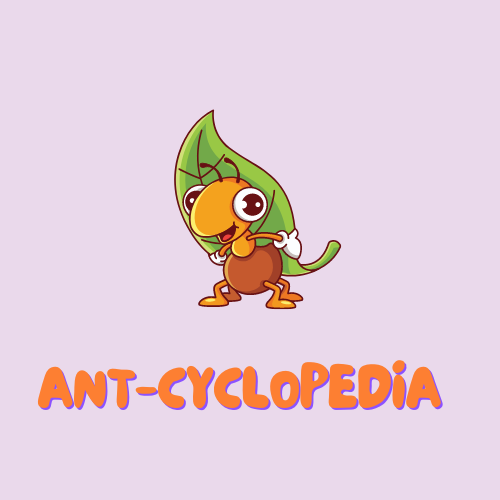
Black garden ants are actually one of the few ant species known to make use of “bartering” when foraging for food. They have been observed exchanging small items like twigs, leaves and even stones with other ant colonies in order to get access to food sources.
Black Garden Ant Photos And Pictures
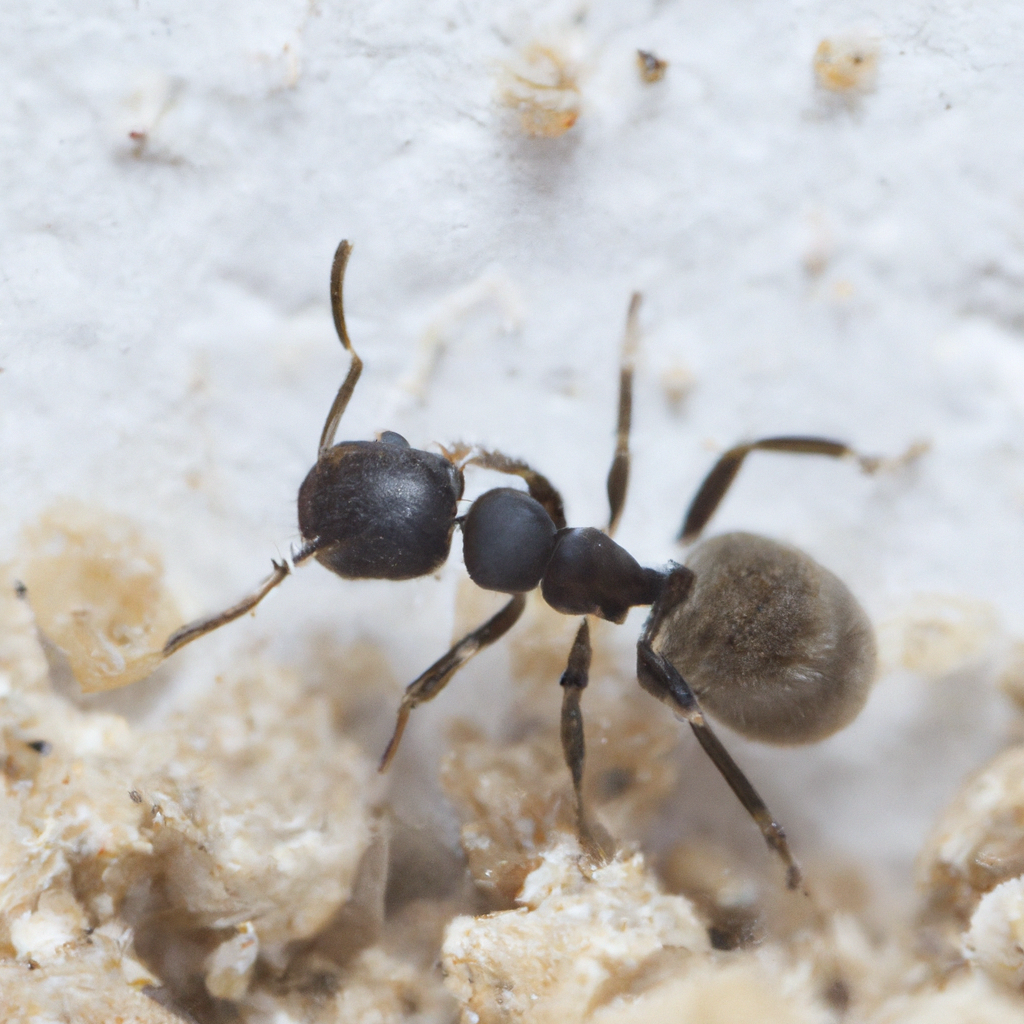



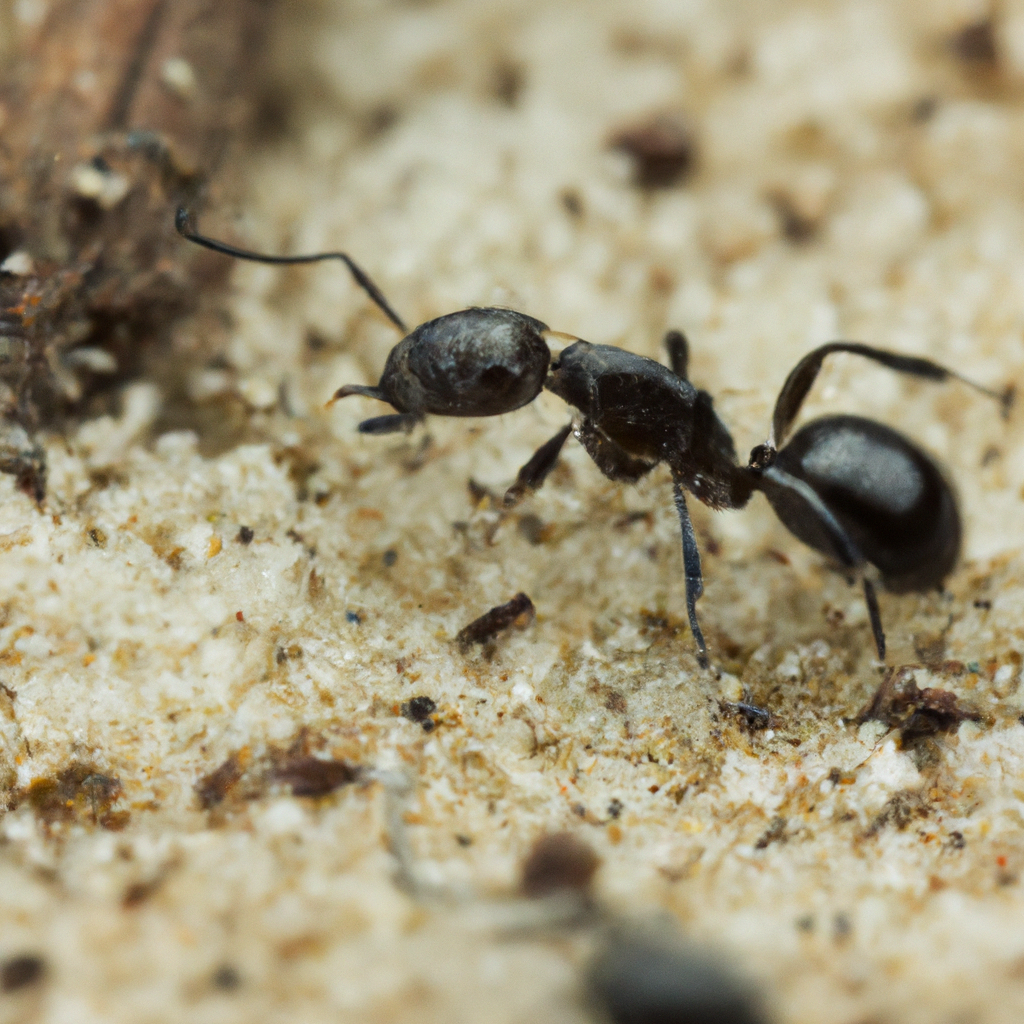

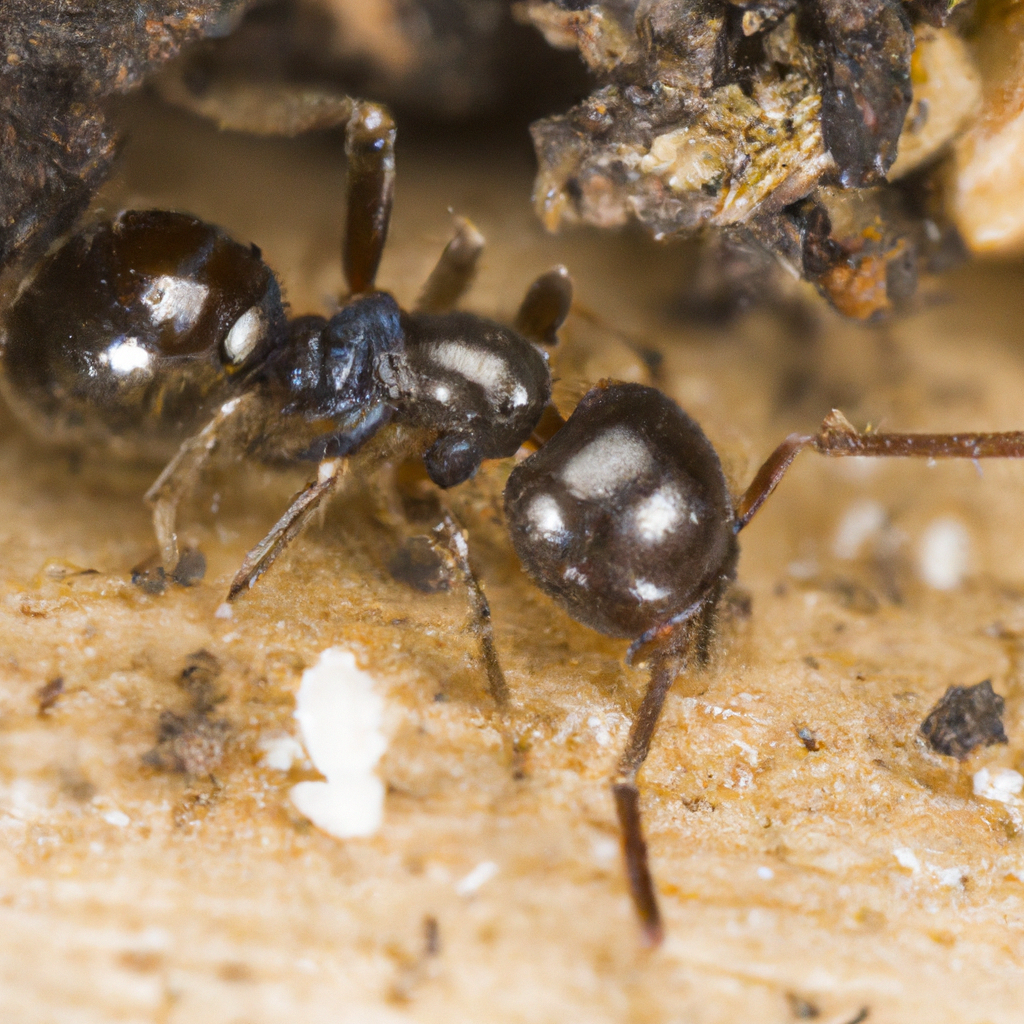

Seasonal Colony Trends [All You Should know]
Black Garden Ant Reproduction (Reproductive Biology)
Black garden ant colonies usually produce eggs year-round, but egg production tends to peak during the warmer months. When eggs are laid they go through a three stage development process: the egg, the larvae and the pupae.
The process generally takes two weeks before new adult ants emerge.
During the warmest part of summer, some queen ants may lay up to 10 eggs per day!This can create large colonies in very short periods of time.
Queen Black Garden Ants (Behavior)
Most colonies have one or more queens which tend to be larger than other workers inside their colony. They live for 2-5 years and are responsible for laying most of the colony’s eggs as well as protecting it from predators and disease threats.
Queens will often leave their original colony in order to found a new one after mating with males from outside nests or colonies; this behavior is known as swarming or budding and contributes significantly to seasonal trends in black garden ant populations across their native ranges.
There’s evidence that environmental conditions like temperature play a role in when these behaviors occur – meaning that black garden ants might swarm or bud at different times depending on where they live!
Impact
Natural Environmental Impact
As with many other species of ants, Lasius Niger has an important role in their local ecosystems. They are predators that help keep populations of small insects such as aphids in check and can play a part in decomposing organic matter.
They also help aerate the soil while they travel through it creating tunnels which can be beneficial for plant growth and nutrient distribution.
Human Impact
The Black Garden Ant’s impact on humans is mostly positive due to its pest control abilities; however, they do sometimes cause minor issues when entering buildings looking for food or nesting sites. If there is an issue caused by this species it is usually easy enough to remove them without any need for chemical extermination methods as they tend not to nest inside dwellings without some kind of invitation from occupants (such as leaving out sweet foods).
YOU CAN ALSO LISTEN HERE!
Post Audio Black Ant pending



Black Ant Education (Black Ant
Life Cycle)
The black ant has four stages in its life cycle.
- They are egg
- Larva
- Pupa
- And adult.
Eggs: Female ants lay eggs which hatch into larvae after several days. The eggs vary in size depending on the species of ant. In some species, the queen may produce a special type of egg called a “queen cell” that will become the next queen when it hatches.
Larvae: The larvae feed on food regurgitated by adults and also receive nutrients from their mother’s body fluids or milk-like secretions produced by her body glands called trophallaxis. During this stage they molt several times until they reach the pupal stage—where they undergo metamorphosis to transform into adults.
Pupae: Pupae are immobile cocoons where ants transition into adulthood over time. This is accomplished through changes in their physiology as well as physical features such as wings and antennae becoming visible during this period of transformation before emerging as an adult worker ant or reproductive female/male mate (depending on caste).
Adult: Adult workers help to maintain colony activities such as finding food sources, caring for young nestmates and defending against intruders or predators from outside threats while reproductives focus more so on reproduction duties like mating with potential mates to create new colonies or expanding upon existing ones with additional resources etc.
Threats To Humans (Black Ant ants harmful?)
As we previously mentioned, the impact that the black garden ant has on humans in most cases is positive due to its great ability to clean areas of dead animals and its ability to keep pests at bay. However, there are some cases in which our path crosses theirs and we can have many headaches due to their ability to conquer land and reproduce on a large scale.
But leaving this detail aside, the answer is no. Black ants are not harmful to humans.
Environmental Habitat Requirements
The black garden ant (Lasius niger) is an extremely successful species of ant that is found throughout the Northern Hemisphere.
It has adapted to a wide range of habitats, including human-modified spaces such as gardens and urban areas.
Although it can be found in virtually any environment where there are decaying organic materials present, they usually prefer warm climates and moist soils; they may also nest under stones or logs or even inside wall cavities. While not picky about its food sources, Lasius niger generally prefers sweet substances such as honeydew excreted by aphids and other insects.
They also feed on various types of animal matter including
Dead insects
Bird Eggs
Eggs, Larvae and pupae from other ants.
Colonies reach their peak size during late summer/early autumn when conditions are most favorable for them to thrive. In order to survive cold winter temperatures the colonies hibernate until warmer weather returns in springtime.
Another factor that can play against black garden ants is the temperature of the environment.
(Maximum temperature 34ºC)
(Minimum temperature 5ºC)
Black Ant Nutrition And Diet
Black ant nutrition and diet is mainly based on a variety of small insects, larvae, caterpillars and other invertebrates. They also feed on nectar, honeydew, pollen and other plant material.
Black ants will often raid the nests of other insects to collect their food sources as well. These ants are omnivorous scavengers that consume anything they can find which provides them with adequate nutrients for survival. In addition to this, black ants may sometimes supplement their diet with honeydew produced by aphids or mealybugs in order to increase their energy intake.
Black Ant Nests and Colonies
These arthropods live in colonies with several hundred to several thousand workers.
The colony is made up of a single queen ant and her offspring, who are primarily female worker ants. The queen lays eggs throughout the year, which then hatch into larvae that are cared for by the worker ants.
A black garden ant colony typically consists of one or more underground nests connected by small tunnels and chambers called galleries. These nests may be as large as two square meters and contain hundreds of thousands of individuals! Workers construct these galleries from soil particles, dung, or other materials they find nearby using their strong jaws and claws. Inside the nest, workers create cells for storing food supplies such as honeydew from aphids or carcasses from dead insects. They also build brood chambers where the larvae develop before emerging as adult ants.
The entire colony acts like a single organism, each working together to ensure its survival. Worker ants constantly patrol around their nest’s perimeter to search for food sources and protect it from intruders such as rodents or other insect predators. If threatened, they will quickly mobilize in defense against an intruder!
Black Ant Queens
Black ants queens have a lifespan that can range from several months to multiple years, depending on the species.
During her lifetime, she will lay hundreds or even thousands of eggs which is essential for keeping the colony alive and well.
These queens also tend to be much larger than their workers and males, measuring up to 2 cm long sometimes!
They mate with one or more males during their life cycle; they establish new colonies by “budding”; they feed on liquid food stored within them as opposed to solid foods like other members of their territory; most black ant queens live underground, but some may nest above ground too; lastly, there can be multiple active queens within one colony at any given time.
The Best Products 2023
Formicarium
Formicarium
Ant Farm
Ecosystem
Entomology supplies
Test Tube Packs
Pipettes
Feeding Dishes
Ant Foods
Ant Nectar
Feeders
Eco-Fresh Rice Worms
Fly Larvae
Kits
Terrarios
Nest Kit
Ant Farm Sand
Ant Farm Neon Gel
Wanna learn more about Ants? Join an Online Community of more than 1000 Readers Around the Country.
Here you can sign in to our newsletter to receive daily emails with funny facts, interesting details about ants, step-by-step tutorials, and even good practices to have a healthy ant farm colony. We’ll be more than happy to have you in…

How to Get Rid of Black Ant (Easy Steps)
1 – First Step: Inspection & Control
Black Ant Pest Prevention & Control
Looking for effective ways to prevent and control black garden ant infestations?
We’ll explore the best methods for keeping black garden ants at bay and ensuring your green space stays free from these pesky pests. So grab your gardening gloves, and let’s dive in!
Prevention
1. Remove food sources: Make sure to store food items in airtight containers and seal any cracks or openings near your kitchen, bathroom, and other areas where food is stored. Additionally, make sure to clean up after meals immediately – scraps of food that are left behind can provide a great source of nutrition for black garden ants.
2. Eliminate entry points: Inspect the exterior walls around your home for cracks or crevices that could be providing the ants with an easy access point into your home. Seal off any potential entry points with caulk or some other type of barrier material.
3. Use ant baits: Ant baits are available in a variety of forms, from granules, gels, and sprays – each designed to attract certain types of ants depending on their favorite foods (sweet versus greasy). Place these baits at strategic locations throughout your home in order to draw out large swarms of black garden ants away from your living area before attempting extermination methods such as chemical sprays or traps.
4. Hire professional exterminators: If self-treatment options don’t seem sufficient enough to manage a severe black garden ant infestation, you may wish to hire a professional pest control service who will be able to employ more advanced methods such as foggers and residual insecticides, which have been specifically designed for use against this particular species
2 – Second Step: Natural Methods To get rid of Black Ant
Outdoor And Indoor Organic Pest Control Products
Diatomaceous Earth
Diatomaceous Earth is a naturally occurring soft sedimentary rock that has been ground down to a fine white powder.
This powder damages the exoskeleton of insects, so it acts as a barrier that Black Ants won’t cross.
If you have potted plants on a shelf, you can put a small amount of diatomaceous earth down by the legs of the shelf, preventing ants from getting up onto the plants.
These barriers can be put virtually anywhere, both indoors and outdoors.
While Diatomaceous earth is safe for humans to handle and even eat, it does create fine dust that should not be inhaled.

PROS About Diatomaceous Earth
Among its most striking advantages is the low risk to the health of people, children, and pets, as well as the residual years that this compound can have in our home, providing extra protection against pests. This material is not recommended for use on carpets or floors that you would vacuum.
CONS About Diatomaceous Earth
Although this product represents a non-chemical solution to avoid chemical pesticides. This powder can have some drawbacks. An example of this is that insects need to have direct contact with the material, as well as prolonged contact for it to have a greater effect. This means, that if we decide to use this. We must distribute it throughout our home in large quantities. On the other hand, Diatomaceous Earth must be kept dry, so it is not a good idea if we want to use it in our gardens that are damp from irrigation.
Despite its low toxicity. This material could not be used to kill ants if it did not have some level of danger to the health of insects, so the use of dust masks is recommended, as well as applying it in ventilated areas since this dust could cling to the mucous membranes of the nose and mouth. Also, the dust could fly and generate allergies if we apply it in places where there are fans or air conditioning.
Boric Acid
Boric Acid is a type of Acid found in many naturally occurring minerals, such as borax. Borax is found in many cleaning products, including some types of toothpaste.
Boric Acid has a very low toxicity level for mammals but not for ants. It interferes with their digestive system and slowly terminates them.
The trick is to keep the level of boric Acid low enough so that it travels through the colony and makes it to the queens and young before killing the ants.
I will give you a personal recommendation of a product that is currently on the market called Terro. This contains borax, and I found it effective against Black Ants.
You can also find recipes online to make your own bait at home using borax. (Here are the steps if you are interested)
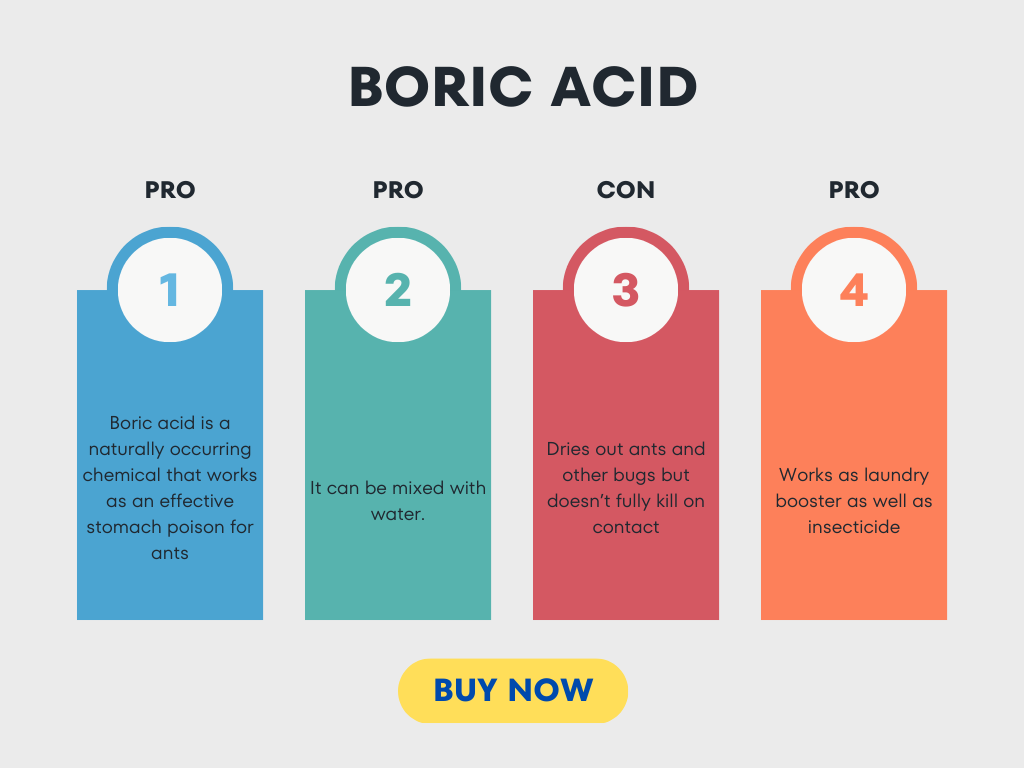
PROS About Boric Acid
This product dissolves easily in water, which allows us significant savings. On the other hand, it is more granular than powder. Which makes it less likely that we will inhale it by mistake.
It is useful for other types of pests, such as cockroaches.
CONS About Boric Acid
In very humid climates, if not stored properly, it can become damp and ruined. Therefore, it is recommended to store the mixture in a gallon Ziploc bag to keep it dry and protected when not in use.
Essential oils
Black Ants communicate with each other using pheromones. A forager that finds food marks a trail on the way back to the colony. This scent trail is followed by other ants, and these ants then reinforce the trail when they head back to the colony with food.
Pheromones also help ants tell each other apart, warn each other of danger and communicate all sorts of messages we’re only beginning to understand.
Most essential oils have a very strong fragrance. We can use this strong fragrance to mask pheromone trails and disrupt the coordination of ants. This method, in addition to being very efficient, allows you to drive away the ants in a natural way without causing them harm.
Essential oils can be added to soapy water that can be used to clean pots and shelves where we keep cacti and succulents. This will mask any previous messages ants left behind to tell other ants… HEY! There is a good food source, water, or shelter.
My Favorite essential oils to use for ants are:
- Peppermint
- Cedarwood
- Lemongrass and
- Clover
However, there is a high range of essential oils that we can use to keep ants away from our homes. Below we offer you a select list of the most efficient oils with the best results on the market.

Pros About Essential Oils
These essential oils represent rapid elimination and residual repellency. which means many months of additional protection.
On the other hand, this represents a highly respectful pest control with our environment.
In the case of living with other beneficial insects for us, such as bees or other pest-control insects. These represent minimal risk.
Finally, as we all know. Essential oils offer us a natural and pleasant fragrance for our home.
Cons About Essential Oils
Essential oils are very useful for many purposes despite their effectiveness in pest control. We may need large amounts to eradicate large ant colonies. Essential oils are expensive, so it can cost us a few dollars to completely eradicate an ant colony.
3 – Third Step: Insecticides and Ant Baits To Control Black Ant (Best Black Ant Killer)
Best Ant Bait For Black Ant
Borax ant bait is one of the best bait to use for black ants. It’s a combination of powdered boric acid, sugar, and water that can be used as an effective home remedy for ant control. Borax works by killing ants upon ingestion and has no effect on other insects or animals. To make your own Borax ant bait, you will need: 2 tablespoons of boric acid, four teaspoons of sugar, and 1/2 cup of warm water. Mix all ingredients together until it forms a paste, then place it in areas where you are experiencing ant activity, such as doorways, windowsills, countertops, etc.
Some more options might be:
- Baits (protein/fat-based baits).
- Honeydew Aphid Baits
- nectar baits
- Plant product baits as well as sugary carbohydrates.
Black Ant Control Using Insecticides
1. Apply a perimeter spray of an insecticide containing bifenthrin or permethrin around the exterior walls and foundation of your home. Focus on cracks, crevices, and entry points in particular. Reapply every 4-6 weeks as needed for ongoing ant control.
2. Use bait stations to attract ants indoors with a sweet food source such as honey or syrup; once the ants have been attracted to the bait station, apply an insecticide containing fipronil or imidacloprid directly inside it so that when they return to their nest, they will spread the poison throughout the colony. Reapply monthly for maximum effectiveness.
3. Additionally, you can use an aerosol spray containing pyrethrins indoors to kill existing black ant populations quickly and efficiently – be sure not to apply these sprays near any animals or children who may come into contact with them!
Pesticide
Black Ant Control Using Pesticides
Pesticides are a common method of black ant control.
The most effective ones to use contain boric acid, pyrethroids, and carbamates.
Each pesticide should be applied cautiously as they can have adverse effects on plants, humans, and pets.
To ensure maximum effectiveness in controlling the black ants’ population, it is important to identify where the problem areas are located so that the proper amount of pesticide can be used accordingly. It is also advised to regularly check for signs of their presence following an application and re-apply if necessary.
Finally, good sanitation practices should be employed such as removing sources of food for them (e.g., spilled pet food).
Subfamilies Of Ants
View More
View More
Ant SubFamily Group 3
View More

Did You Know That…
Chemical ant control can be effective, but it should only be used as a last resort.
Before using any chemical treatment for ants, you should try natural methods first such as improving sanitation and removing food sources that may attract the pests.
Additionally, certain types of pesticide treatments must be applied directly to ant nests in order to be effective.
YOU CAN ALSO LISTEN HERE!
Pending Audio
How to Raise a Black Ant Colony? The Ultimate Guide
Raising an ant colony can be a fun and fulfilling experience, but it’s important to have all the right information before starting.
In this ultimate guide, we’ll cover everything from how to select the perfect habitat for your ants, to what type of food they need to thrive. Whether you’re a seasoned insect enthusiast or just curious about raising colonies of these fascinating creatures, this guide will give you all the tips and tricks needed for success.
So let’s get started on creating a thriving black ant colony together!
Chapter 1: Getting Started in Black Ant Keeping!
1. Gather Your Supplies: You’ll need a formicarium (ant colony habitat), sand, food and water sources, ant-keeping medium such as vermiculite or plaster of Paris, white vinegar for mold prevention, and some type of entranceway.
2. Choose A Species Of Black Ants: There are many species of black ants that you can raise in captivity. Common choices include Camponotus pennsylvanicus (black carpenter ants) or Lasius niger (European black garden ants). Also consider the local ant populations where you live to make sure you choose an appropriate species for your area.
How to get a Black Garden queen ant?
You can get a Black Garden queen ant by purchasing them from an ant farm, pet store, or online retailer that specializes in live insects.
Some stores may have ready-to-go colonies with the queen and her workers already established.
Alternatively, you could begin your own colony from scratch by purchasing just a single queen and some of her eggs/larvae to start your own colony!
3. Set Up The Formicarium: Place sand at the bottom of the formicarium so it will provide a moist environment for your ants to thrive in. Add food and water sources before adding any additional substrate like vermiculite or plaster of Paris to help insulate the nest from changes in temperature over time and provide extra moisture when necessary. Top off with a small entrance way for easy access into the formicarium by your new colony members!
4 . Introduce The Colony To Their New Home : Get ready to introduce your worker ants into their new home! Do this carefully – if they are placed too close together they may fight each other due to territorial issues, so spread them out across different parts of the formicarium initially until they get used to living together as one unit later down the line after establishing rankings within her hierarchy system called ‘trophallaxis’ where she delegates tasks among her workers/soldiers etc… Once done don’t forget also fill up their food source every week with a nutritionally balanced diet & change up their water supply regularly as well!
How to identify a Carpenter queen ant?
Carpenter queen ants are identified by their larger size and bright orange-red color.
They can also be distinguished from other ant species by the presence of a long, curved mandible that appears at a 45 degree angle.
Additionally, Carpenter queen ants have an overall broader body shape than other common ant species.
Time for a black garden queen ant to start a new colony
The timeframe will vary depending on the species. Generally, a queen ant will start to form her colony in 3-4 weeks after establishing herself.
Next Steps
5 . Monitor The Behaviour Of Your Black Ant Colony : As with all colonies it is important to monitor behaviour closely – does this mean regular observations? Yes! It’s absolutely essential that you keep an eye on how things progress within its environment; look out signs such as aggression between individuals which may indicate problems with overcrowding OR insufficient resources being provided i.e not enough food resulting in fights over limited amounts available etc… If any obstacles arise then take action quickly like placing more resources/food around /changing up nesting material if needed etc…
6 . Keep An Eye On Pests And Diseases : Keeping pests away from your black ant colony is very important.
How to feed your Black Garden Ants
1. For food, Black Garden Ants need a combination of protein and carbohydrate sources such as bits of fruit (e.g., grapes), cooked egg, small pieces of boiled potato or sweet foods like honeydew melon.
2. Place the food in several dishes around their habitat so that it is easily accessible for them to find and feed on during the day. Create piles with two millimeters between each piece so they can crawl through if need be.
3. Make sure the food is fresh and not spoiled or moldy as this can make your ants ill! Remove any uneaten food after 24 hours to prevent contamination from occurring within their habitat.
4. Provide extra water by putting drops of water directly onto stones found in their habitats to ensure they stay hydrated throughout the day – otherwise provide a shallow dish filled with clean water which should be changed regularly to avoid bacteria build up over time!
I am starting the breeding of Black Ants!
Congratulations on your new endeavor! Breeding black ants is a fascinating hobby that requires patience and skill.
Here are some final tips to get you started:
1. Research the type of black ant you plan to breed. It’s important to understand their habits, nutrition needs, mating behaviors, lifecycle stages and environment requirements before starting a colony.
2. Find a suitable place for your breeding colony – such as an outdoor garden or terrarium – where they will have plenty of room to move around and access food sources in order to thrive. Check local laws to make sure it’s legal before establishing your colony outdoors.
3. Purchase an established black queen ant with her own workers from a reputable breeder or find one in the wild if allowed by law (make sure she has been inspected for parasites). Establishing a mature nest can be difficult so purchasing an established queen is often recommended over capturing one in the wild or starting from scratch with eggs/larvae/nymphs only unless you’re experienced at raising queens from larvae stage up into adulthood successfully .
4. Provide a warm humid habitat with lots of hiding places and airflow; provide fresh soil (or sand) for digging tunnels; supplement natural food sources like fruit flies with protein-rich foods like cricket powder; ensure proper hydration and maintain the temperature between 28-30 degrees Celsius (82-86 Fahrenheit); avoid direct sunlight exposure during hot months when temperatures may exceed 30C (86F).
5. Monitor them regularly for signs of health issues such as mites, fungus growth or deformities which could indicate infections or illnesses; also check regularly for any dead ants which need removal so that disease doesn’t spread inside the nest quickly – use tweezers when moving bodies out without touching other living individuals directly as this can spread infection quicker than expected!
Lastly don’t forget regular cleaning sessions using alcohol wipes & cotton swabs especially after handling food items etc., this helps prevent cross contamination too!



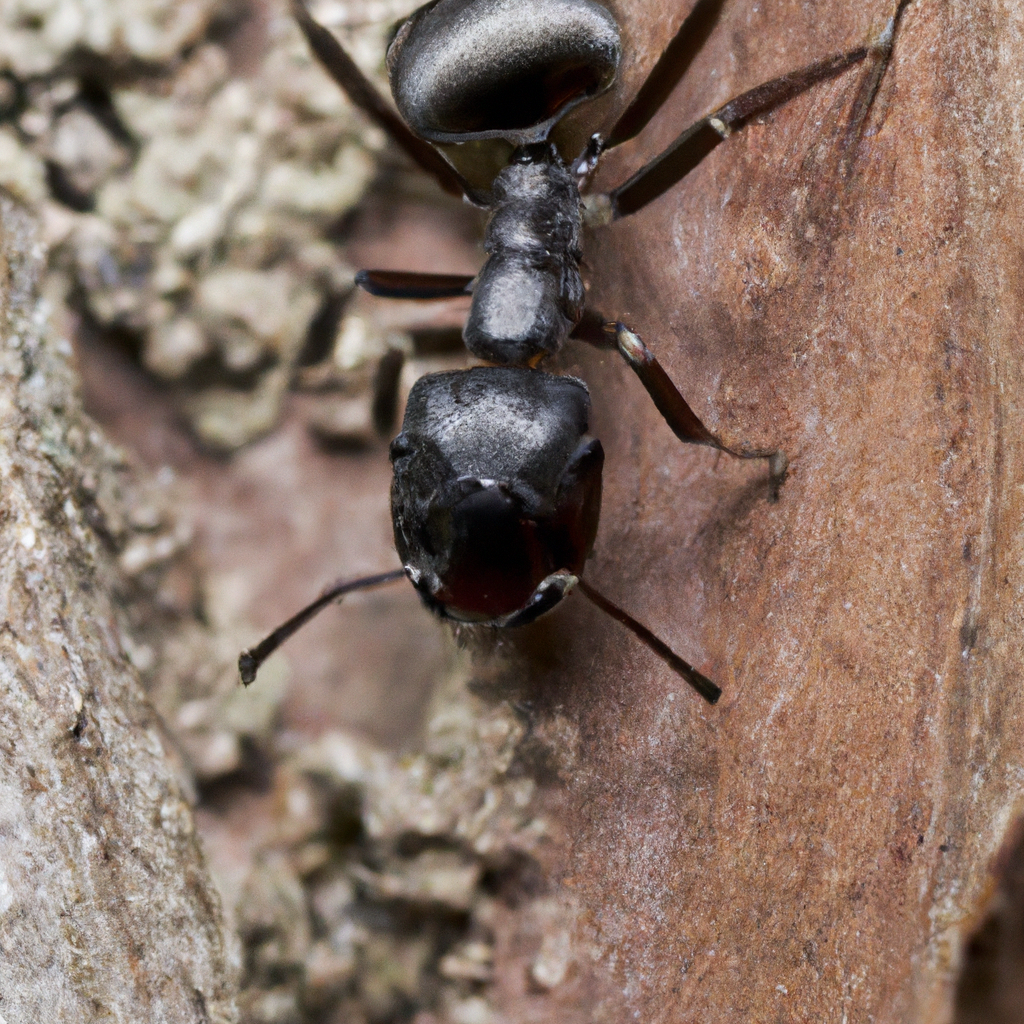
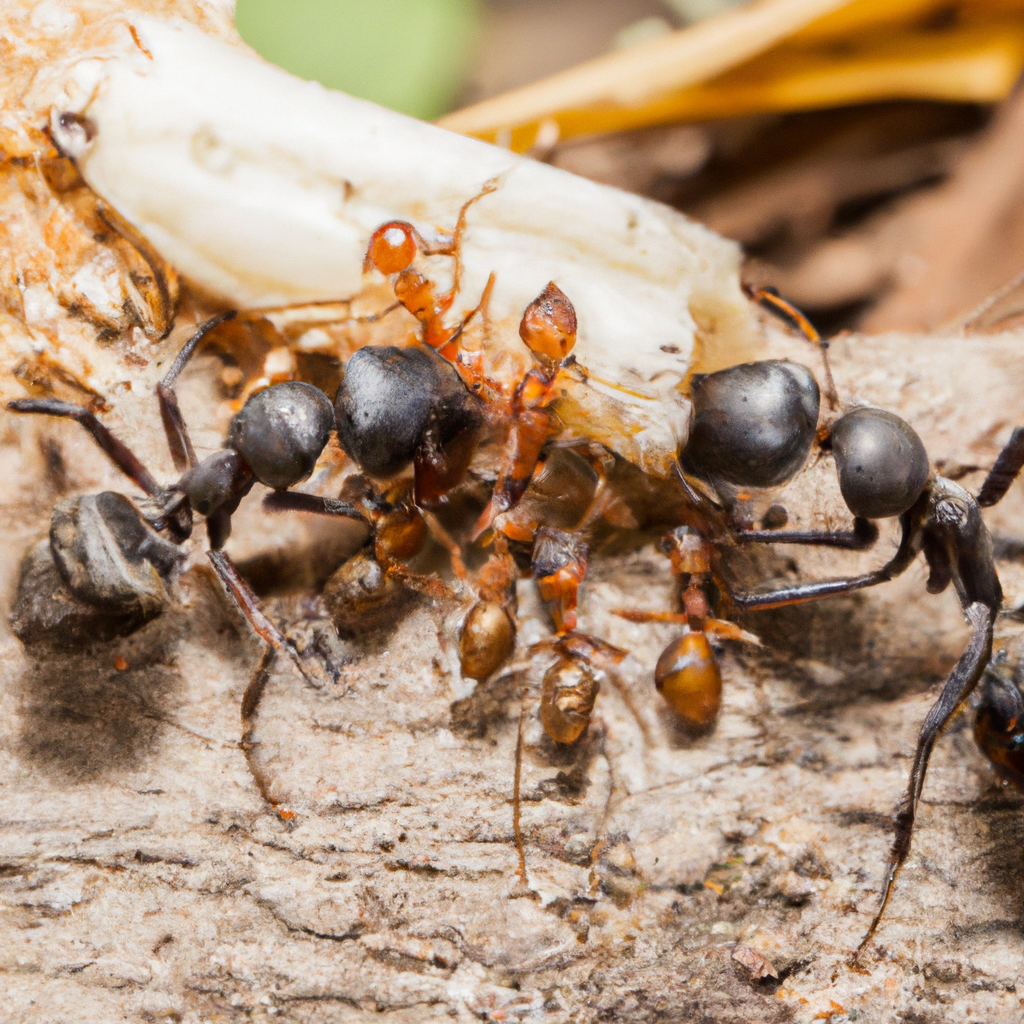
The Best Products 2023
Formicarium
Formicarium
Ant Farm
Ecosystem
Entomology supplies
Test Tube Packs
Pipettes
Feeding Dishes
Ant Foods
Ant Nectar
Feeders
Eco-Fresh Rice Worms
Fly Larvae
Kits
Terrarios
Nest Kit
Ant Farm Sand
Ant Farm Neon Gel
Ant Farm Ecosystems
| Ant Farm For Classroom | Light-up Ant Habitat |
| Ant House With Feeding Area | Wall Hanging Ant Farm |
| An ecosystem with live ants | Ant farm for Preschool |
| Pet Anthill Ant House | Nest Insect Castle |
| Glow In The Dark Ant Farm | Aquariums For Ants |
| Ant Farm With Instructions | Ant Farm With Queen |
| LED Ant Farm for Live Ants | Connectable Ant Farm |
| Ant Farm For Kids | New Large Plaster Ant Farm |
| Pocket colony | Ant Farm With Queen |
Ant Farm Supplies
| Feeder | Feeding Area |
| Tunneling sand | Tunnel starter tool |
| Ecological Ant farm gel | Ants farming aphids |
| Nutrition and Care | Ants farming mushrooms |
| Ecological blue gel | Fungus for ant farms |
| Handcrafted Wood | Ant habitats |
| Ant Plastic Tubes | Ant Glass Tubes |
| Food for ants | Ant Farm Nectar |
| Ant Farm Live Insects | More Supplies |
Live Ants For Sale
| Live Ants | Best ant species |
| Coolest Ants To Keep | Interesting Ants |
| Fungus-farming ants | Exotic ants |
| Big Ants | Buy Queen Ant |
| Buy Worker Ants | Buy Soldier Ants |
| Domestic ants | Fungus farming ants |

